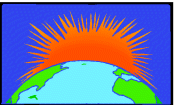

Aurora
 On certain nights at high latitudes shifting patterns of light may been seen in the sky. These are the aurorae. The bright lights are caused by high-energy particles streaming out from the Sun - the solar wind - striking the Earth's upper atmosphere or ionosphere. Energy from these electrically charged particles is converted into light, forming visible glows, rays, arcs, bands and veils. This light is usually greenish, but is sometimes red as well. The charged particles are attracted by the Earth's magnetic field. Near the magnetic poles, the Earth's magnetic field becomes much stronger. Consequently, it is nearer the magnetic poles that the aurorae are most frequently witnessed.
On certain nights at high latitudes shifting patterns of light may been seen in the sky. These are the aurorae. The bright lights are caused by high-energy particles streaming out from the Sun - the solar wind - striking the Earth's upper atmosphere or ionosphere. Energy from these electrically charged particles is converted into light, forming visible glows, rays, arcs, bands and veils. This light is usually greenish, but is sometimes red as well. The charged particles are attracted by the Earth's magnetic field. Near the magnetic poles, the Earth's magnetic field becomes much stronger. Consequently, it is nearer the magnetic poles that the aurorae are most frequently witnessed.
The power of aurorae depends mostly on the strength of the solar wind. During an intense solar storm, the wind can intensify very strongly, and aurorae may be seen at lower latitudes further from the magnetic poles. Every 11 years, at the peak of the sunspot cycle there is an increase in intensity of the solar wind, and with it, an increase in frequency and intensity of auroral displays.
Aurorae occur in both the Northern and Southern Hemispheres. In the Northern Hemisphere, the display is known as the aurora borealis, or northern lights. In the Southern Hemisphere, it is called the aurora australis, or southern lights. The term aurora polaris, polar lights, is a general name for both. Aurorae are usually visible from within the Arctic or Antarctic circles - Antarctica, Greenland, Iceland and Northern regions of Canada, Alaska, Scandinavia and Russia. During times of more intense activity on the Sun, auroral storms can be viewed at lower latitudes such as northern Scotland and most of Norway, Sweden and Finland. Very rarely displays can be seen from northerly parts of Europe and the United States.
 | Aurora Borealis |
Websites
Other topics
• Aurora Gallery
• Northern Lights Planetarium
• Aurora Borealis
• Aurora Australis
• Northern Lights
• Northern & Southern Lights
• Weather Doctor
• Introduction
• Aerosols
• Air
• Air Gases
• Air Layers
• Aurora
• Blue Sky
• Clouds
• Coriolis Force
• Cosmic Rays
• Energy
• Exosphere
• Ionosphere
• Jet Stream
• Magnetosphere
• Mesosphere
• Meteors
• Moisture
• Nitrogen
• Oxygen
• Ozone Hole
• Ozone Layer
• Pollution
• Pressure
• Stratosphere
• Temperature
• Thermosphere
• Trace Gases
• Troposphere
• Weather
• Wind
 Print Topic
Print Topic